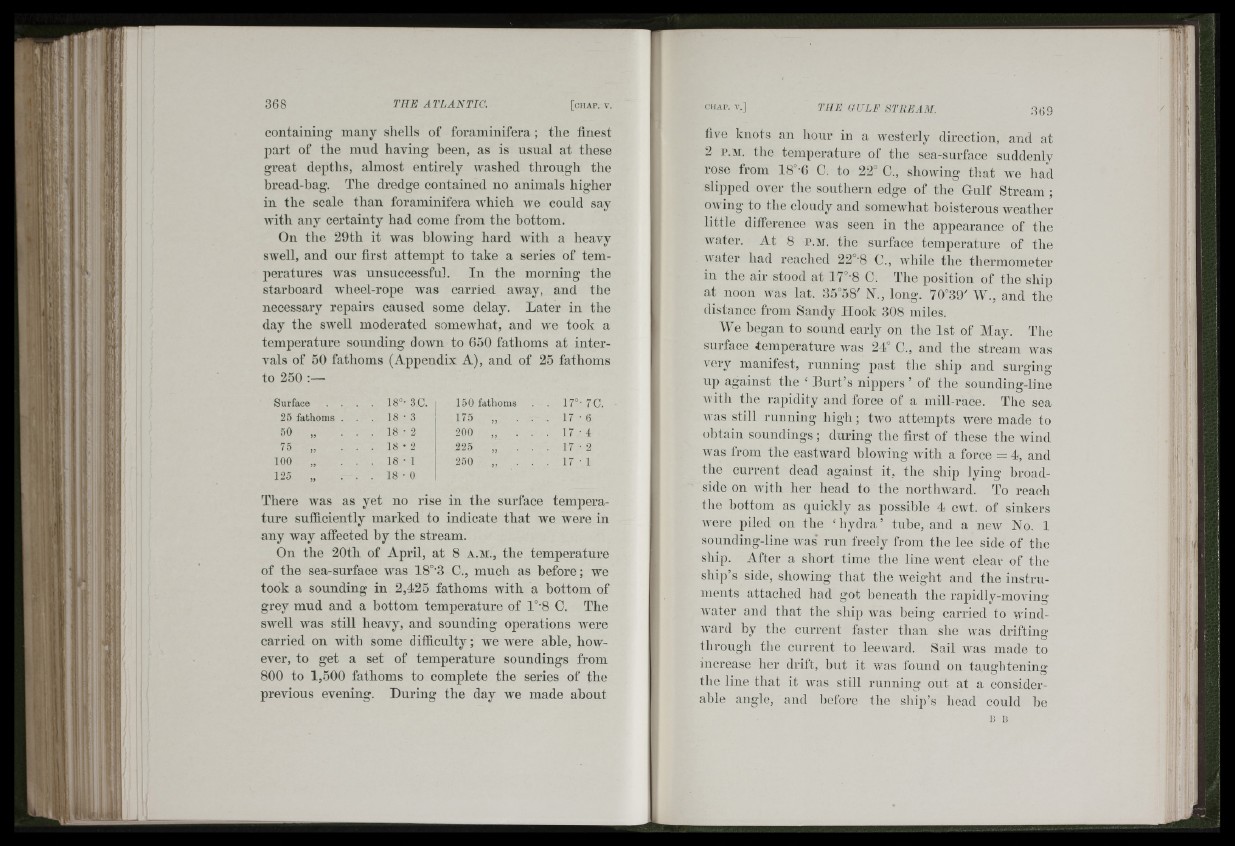
l ì«
m i
il
ill:
containing many sliells of foraminifera ; the finest
part of the mud having been, as is usual at these
gi’eat depths, almost entirely washed through the
bread-hag. The dredge contained no animals higher
in the scale than foraminifera which we could say
with any certainty had come from the bottom.
On the 29th it was blowing hard Avith a heavy
swell, and our first attempt to take a series of temperatures
Avas imsuccessful. In the morning the
starboard wheel-rope was carried away, and the
necessary repairs caused some delay. Later in the
day the SAvell moderated somewhat, and we took a
temperature sounding doAvn to 650 fathoms at intervals
of 50 fathoms (Appendix A), and of 25 fathoms
to 250
Surface . . . 18°- 30. 150 fathoms
25 fathoms . . . 18 • 3 175 J) . . .
50 „ . . . 18-2 200 . . .
15 ,, . . . 18-2 225 J, . . .
100 „ . . , 18-1 250 J,
1 125 „ . . . 18-0
There was as yet no rise in the surface
17°
17
17
17
17
7C.
6
4
21
ture sufficiently marked to indicate that we were in
any way affected hy the stream.
On the 20th of April, at 8 a .m ., the temperature
of the sea-surface was 18°'3 C., much as before; we
took a sounding in 2,425 fathoms Avith a hottom of
grey mud and a bottom temperature of 1°'8 0. The
swell Avas still heavy, and sounding operations Avere
carried on Avith some difficulty; we were able, however,
to get a set of temperature soundings from
800 to 1,500 fathoms to complete the series of the
previous evening. During the day we made ahout
live knots an lioiir in a Avesterly direction, and at
2 P.M. the temperature of the sea-surface suddenly
rose from 18°'6 C. to 22° C., showing tliat aa’o had
slipped over tlie southern edge of the Gulf Stream ;
owing to the cloudy and somewhat boisterous Aveather
little difference Avas seen in the appearance of the
Avater. A t 8 p.m. the surface temperature of the
Avater had reached 22°‘8 C., Avhile the thermometer
in the air stood at 17°‘8 C. The position of the ship
at noon was lat. 35°58' N., long. 70°39' W., and the
distance from Sandy Hook 308 miles.
We began to sound early on the 1st of May. The
surface temperature Avas 24° C., and the stream Avas
very manifest, running past the ship and surging
up against the ‘ Burt’s nippers ’ of the sounding-line
Avith the rapidity and force of a mill-race. The sea
Avas still running h ig h ; two attempts Avere made to
obtain soundings; during the first of these the wind
Avas from the eastAvard hloAving Avith a force = 4, and
the current dead against it, the ship lying broadside
on Avith her head to the nortliAvard. To reach
the hottom as quickly as possible 4 cwt. of sinkers
Avere piled on the ‘hydra’ tube, and a neAv No. 1
sounding-line Avas run freely from the lee side of the
ship. After a short time the line Avent clear of the
ship’s side, shoAving that the AA'eight and the instruments
attached had got beneath the rapidly-moving
Avater and that the ship Avas heing carried to AAund-
Avard by the current faster than she Avas driftingo
th r o u g h th e c u r r e n t to le ew a rd . Sail AA’a s m a d e to
in c r e a s e h e r d r ift, b u t i t vvas ib u n d o n tau gOh ten i'n o“-
the line that it Avas still running out at a considerable
angle, and hefore the ship’s head could he
]; 13
llif.’t i l , •m' i
iifC .